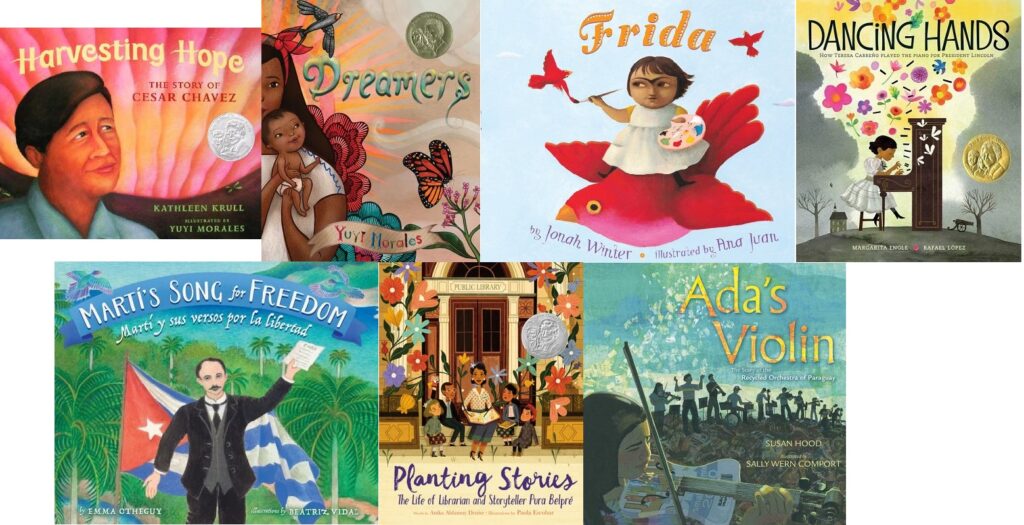This post was written by NCTE member Kasey Short.
Nonfiction picture books provide an opportunity to introduce students to various topics, events, cultures, and people over a short period of time. The books included are nonfiction picture books that can be used to honor, celebrate, and explore Hispanic Heritage Month. Student of all ages benefit from having books read aloud to them and exploring the connection between the words and pictures on each page. The questions were designed with middle school students in mind, but many could be used and/or adapted for younger students.
Harvesting Hope: The Story of Cesar Chavez  by Author Kathleen Krull and Illustrator Yuyi Morales
by Author Kathleen Krull and Illustrator Yuyi Morales
Overview: This book tells the story of Cesar Chavez, a Mexican American who organized a non-violent protest to improve the inhumane conditions that Mexican American farm workers faced. It shows how his courageous, determined, and hopeful mindset helped him work to bring about positive change.
Questions and Activities
- Cesar Chavez credits his mother with teaching him to resolve conflicts in a peaceful manner. What examples in the book show that he lived by this belief? How did using peaceful means to protest, help him achieve his goal?
- Why did Cesar want to develop the National Farm Workers Association? How did the association help farm works?
- Discuss how the following words connect to the story: Hope, Family, Prejudice, Injustice, Determination, Organization, Patience.
- Cesar’s motto was “Si se puede!”, which translates to English as “Yes, it can be done!” How does that motto fit his life and accomplishments? How could you apply that motto to your life and/or an issue going on today?
- How does this story connect to other things you have learned about Hispanic Heritage Month?
Curriculum Connections: History
The Cesar Chavez Foundation website explains what the foundations is currently doing today and more.
Dreamers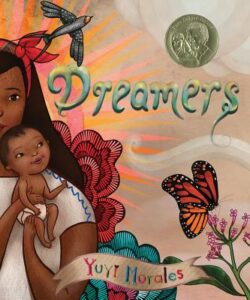 by Author Yuyi Morales
by Author Yuyi Morales
Overview: A immigrant mother shares her experiences being in a new country with her young child where she can’t speak English. She finds a public library and books transform her ability to read, write, and speak English as well as inspire her dream about their future. The lyrical language, Spanish words woven throughout the book, and vibrant illustrations draw in the reader and paint a picture of the women’s emotions and dreams.
Questions & Activities:
- What do you think the butterfly on the cover the book represents?
- How does the access to a public library impact the mother?
- Why do you think the author includes some Spanish words in the story? How does the inclusion of these words impact the story?
- Why do you think the author named the book Dreamers?
- Read the autobiographical essay at the end of the book. How did her own experiences influence the book?
- The author was inspired by books, what books have inspired you in your life? Are there any picture books that you remember reading over and over as a child? Why do you think you enjoyed reading them so many times?
- How does this story connect to other things you have learned about Hispanic Heritage Month?
Curriculum Connections: World Geography, Library Science, English
Check out this link to listen to the author read the book aloud. The author also pauses to ask questions during the story, explains her own connections to the story, and engages with the audience. Make sure to listen to the questions with the author at the end.
Frida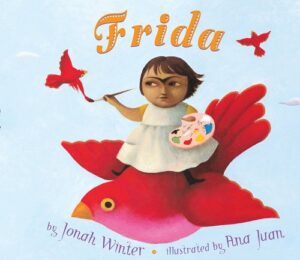 by Author Jonah Winter and Illustrator Ana Juan
by Author Jonah Winter and Illustrator Ana Juan
Overview: The book gives an overview of Frida Kahlo’s life through simple sentences and brilliant illustrations. It showcases what inspired her to be an artist, the hardships she faced, and the importance of art in her life.
Questions & Activities
- When and how did Frida discover drawing?
- How did Frida’s culture, family, and childhood impact her as an artist?
- What is an adjective you would use to describe Frida based on this book? Explain why.
- After reading the picture book, what questions do you still have about Frida Kahlo?
- What can you learn about Frida by looking at the self-portraits below? How did she see herself? What was important to her?
- How does this story connect to other things you have learned about Hispanic Heritage Month?
Curriculum Connections: Art, History
Read more about this text on the author’s website.
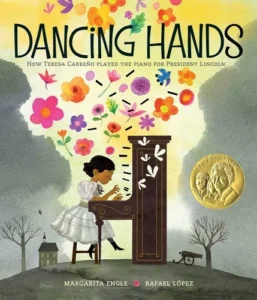 Dancing Hands: How Teresa Carreño Played the Piano for President Lincoln by Author Margarita Engle and Illustrator Rafael López
Dancing Hands: How Teresa Carreño Played the Piano for President Lincoln by Author Margarita Engle and Illustrator Rafael López
Overview: This book tells the story of Teresa Carreño. She was born in Venezuela but during a revolution and her parents fled their home country and came to America during the Civil War. Teresa sang and played the piano from the time she was a young girl and had opportunities to play for various audiences in America. When she was 10 years old, she played the piano for Abraham Lincoln. The author uses poetry, details, and figurative language, along with vibrant pictures from illustrator, to bring Teresa Carreño’s story to life.
Question & Activities:
- How did the color scheme of the illustrations change after Teresa left Venezuela? Why do you think the author and illustrator made this change and what was the impact? When are other times in the story you notice a change of color scheme and how does it impact the story?
- How did Teresa feel when she came to America? What differences did she notice between Venezuela and America?
- How did her music impact President Lincoln?
- What can we learn from Teresa’s story?
- How does this story connect to other things you have learned about Hispanic Heritage Month?
Curriculum Connections: History, Music, English (poetry, figurative language)
View this curriculum guide with questions and activities designed by the publisher.
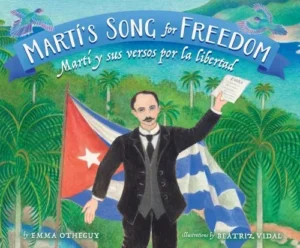 Martí’s Song for Freedom: Martí Y Sus Versos Por La Libertad by Author Emma Otheguy and Illustrator Beatriz Vidal
Martí’s Song for Freedom: Martí Y Sus Versos Por La Libertad by Author Emma Otheguy and Illustrator Beatriz Vidal
Overview: This book tells the story of José Martí. He grew up in Cuba when it was colonized by Spain. He saw the injustice all around him and used writing to speak out against Spain. He was forced to leave Cuba and continued to speak out for Cuba’s independence. This book is written in verse and includes both Spanish and English throughout.
Resources/Questions:
- What did you learn about the Island of Cuba during the time it was colonized by Spain?
- How did Abraham Lincoln inspire José?
- How did Jose fight to help Cuba gain independence? What did he do that angered the Spanish rulers?
- What did Jose notice about New York?
- When and why did José return to Cuba?
- What do you think these quotations from the book mean in the context of the story:
“Give the vain man his costly gold That sparkles and burns in fire: To me, give me the endless forest when the sun shines through.”
“I come from every place, and I’m on the road to everywhere: I am art amid the arts, and in the mountains chain, a link.”
“I’ve seen the wounded eagle fly to the clear blue sky, and I’ve seen the snake lie dying from its own poison, alone in its lair.”
- How does this story connect to other things you have learned about Hispanic Heritage Month?
Curriculum Connections: History, English
Visit this link to hear the author reading this book aloud.
This interview with the author shares additional information about José Martí and the author.
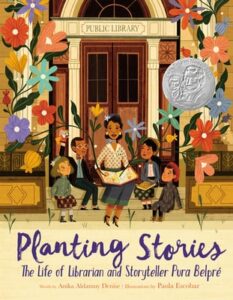 Planting Stories: The Life of Librarian and Storyteller Pura Belpré by Author Anika Aldamuy Denise and Illustrator Paola Escobar
Planting Stories: The Life of Librarian and Storyteller Pura Belpré by Author Anika Aldamuy Denise and Illustrator Paola Escobar
Overview: This book tells the true story of Pura Belpré. She left Puerto Rico and moved to New York in 1921 and after becoming a librarian realized that there were no Puerto Rican stories in the library. She then shared her culture through storytelling. Throughout her life she increased awareness of how important it is to see oneself in stories. She now has a children’s book award in her honor.
Questions and Activities:
- Why do you think the author used Spanish words throughout the book? How did the inclusion of these words impact the story?
- Pura noticed that the library didn’t have any books from Puerto Rico. How do you think that made her feel? What did she do after discovering this? Why is it important for libraries to have books from various cultures?
- How does author use the metaphor of planting seeds to explain Pura Belpré’s impact? What do you think it means to “plant stories?”
- Due to her impact Pura Belpré has a children’s book award named in her honor. Based on the story, what types of books do you think would win her award? Look up the award using the link to see more about her award. Look at the list of books that have won in the past and see if you have read any of them.
- Check out the Teacher Guide from the publisher, it includes lots of great questions and ideas.
- How does this story connect to other things you have learned about Hispanic Heritage Month?
Curriculum Connections: English, Library
Listen to the author reading the book with questions at the end.
Visit to learn more about the Pura Belpré award and list of award-winning books.
Ada’s Violin: The Story of the Recycled Orchestra of Paraguay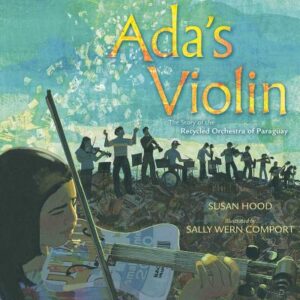 by Author Susan Hood and Illustrator Sally Wern Comport
by Author Susan Hood and Illustrator Sally Wern Comport
Overview: This book tells the true story of Ada Ríos who grew up in a small town in Paraguay that was built on a landfill. It shows her journey of wanting to play the violin but not having an option due to the cost. Then a music teacher came to her town and helped them make musical instruments out of materials in the trash. Ada practiced and her skills improved. She began teaching younger children and then had an opportunity to tour with her orchestra to perform around the world.
Questions and Activities:
- Before making instruments, how did Ada’s community make use of the trash?
- How did the recycled orchestra impact Ada’s life and her entire community?
- What did Ada’s family teach her about music?
- The author’s note at the end of the book provides additional information. Read the note and ask students to consider what new information they learned.
- Examine the pictures throughout the book, what can you learn from the pictures that is not written in words?
- How are the quotations below significant to the story and our world?
“The world sends us garbage. We send back music.”
“Music allowed us to connect with other people. Without even speaking the language, we understand each other.”
“Buried in the trash was music. And buried in themselves was something to be proud of.”
- The last page of the book includes suggested websites and videos to explore, if time allows.
- How does this story connect to other things you have learned about Hispanic Heritage Month?
Curriculum Connections: Environmental Science, Music
Listen to an audio version of this story.
It is the policy of NCTE in all publications, including the Literacy & NCTE blog, to provide a forum for the open discussion of ideas concerning the content and the teaching of English and the language arts. Publicity accorded to any particular point of view does not imply endorsement by the Executive Committee, the Board of Directors, the staff, or the membership at large, except in announcements of policy, where such endorsement is clearly specified.

Kasey Short earned a BA in middle school education from University of North Carolina, Chapel Hill with a concentration in English and history. She earned a Master’s of Education in curriculum and instruction from Winthrop University. She is an 8th-grade English teacher and English department chair at Charlotte Country Day School, North Carolina. Twitter: @Shortisweet3.

